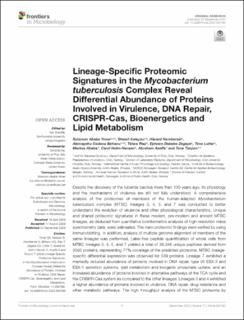| dc.contributor.author | Yimer, Solomon Abebe | |
| dc.contributor.author | Kalayou, Shewit | |
| dc.contributor.author | Homberset, Håvard | |
| dc.contributor.author | Birhanu, Alemayehu Godana | |
| dc.contributor.author | Riaz, Tahira | |
| dc.contributor.author | Zegeye, Ephrem Debebe | |
| dc.contributor.author | Lutter, Timo | |
| dc.contributor.author | Abebe, Markos | |
| dc.contributor.author | Holm-Hansen, Carol | |
| dc.contributor.author | Aseffa, Abraham | |
| dc.contributor.author | Tonjum, Tone | |
| dc.date.accessioned | 2020-09-30T09:28:57Z | |
| dc.date.available | 2020-09-30T09:28:57Z | |
| dc.date.created | 2020-09-16T14:35:38Z | |
| dc.date.issued | 2020 | |
| dc.identifier.citation | Frontiers in Microbiology. 2020, 11:550760 1-19. | |
| dc.identifier.issn | 1664-302X | |
| dc.identifier.uri | https://hdl.handle.net/11250/2680460 | |
| dc.description.abstract | Despite the discovery of the tubercle bacillus more than 130 years ago, its physiology and the mechanisms of virulence are still not fully understood. A comprehensive analysis of the proteomes of members of the human-adapted Mycobacterium tuberculosis complex (MTBC) lineages 3, 4, 5, and 7 was conducted to better understand the evolution of virulence and other physiological characteristics. Unique and shared proteomic signatures in these modern, pre-modern and ancient MTBC lineages, as deduced from quantitative bioinformatics analyses of high-resolution mass spectrometry data, were delineated. The main proteomic findings were verified by using immunoblotting. In addition, analysis of multiple genome alignment of members of the same lineages was performed. Label-free peptide quantification of whole cells from MTBC lineages 3, 4, 5, and 7 yielded a total of 38,346 unique peptides derived from 3092 proteins, representing 77% coverage of the predicted proteome. MTBC lineage-specific differential expression was observed for 539 proteins. Lineage 7 exhibited a markedly reduced abundance of proteins involved in DNA repair, type VII ESX-3 and ESX-1 secretion systems, lipid metabolism and inorganic phosphate uptake, and an increased abundance of proteins involved in alternative pathways of the TCA cycle and the CRISPR-Cas system as compared to the other lineages. Lineages 3 and 4 exhibited a higher abundance of proteins involved in virulence, DNA repair, drug resistance and other metabolic pathways. The high throughput analysis of the MTBC proteome by super-resolution mass spectrometry provided an insight into the differential expression of proteins between MTBC lineages 3, 4, 5, and 7 that may explain the slow growth and reduced virulence, metabolic flexibility, and the ability to survive under adverse growth conditions of lineage 7. | |
| dc.language.iso | eng | |
| dc.rights | CC BY 4.0 | |
| dc.title | Lineage-specific proteomic signatures in the Mycobacterium tuberculosis complex reveal differential abundance of proteins involved in virulence, DNA repair, CRISPR-Cas, bioenergetics and lipid metabolism | |
| dc.type | Peer reviewed | |
| dc.type | Journal article | |
| dc.rights.holder | © 2020 Yimer, Kalayou, Homberset, Birhanu, Riaz, Zegeye, Lutter, Abebe, Holm-Hansen, Aseffa and Tønjum. | |
| dc.description.version | publishedVersion | |
| cristin.ispublished | false | |
| cristin.fulltext | original | |
| cristin.qualitycode | 2 | |
| dc.identifier.doi | 10.3389/fmicb.2020.550760 | |
| dc.identifier.cristin | 1830514 | |
| dc.source.journal | Frontiers in Microbiology | |
| dc.source.volume | 11:550760 | |
| dc.source.pagenumber | 1-19 | |
| dc.relation.project | Norges forskningsråd: 298410 | |
| dc.relation.project | Norges forskningsråd: 261669 | |
| dc.relation.project | Norges forskningsråd: 204747 | |
| dc.relation.project | Norges forskningsråd: 192468 | |
| dc.relation.project | Norges forskningsråd: 234506 | |
| dc.relation.project | Norges forskningsråd: 197467 | |
